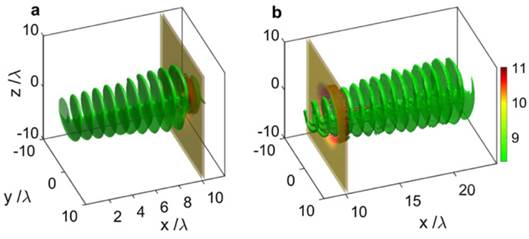On April 21, the top international journal in plasma physics named Nuclear Fusion (CAS Quartile: Q1) published a research paper titled “Topological control of laser-driven acceleration structure for producing extremely bright ion beams”, which is a significant research on the proton beam with high collimation and high energy density led by the Center for Advanced Material Diagnostics (hereinafter referred to as the Center) of Shenzhen Technology University (SZTU). The corresponding authors of the paper are Prof. Zhou Cangtao, dean of College of Engineering Physics and director of the Center, and Prof. Ruan Shuangchen, president of SZTU. The co-first authors are Assistant Professor Ju Libao and Associate Professor Huang Taiwu from the Center. The research was done in cooperation with Prof. Qiao Bin from Peking University, Researcher Zhu Shaoping from Beijing Institute of Applied Physics and Computational Mathematics and so on. The full text can be found at: https://iopscience.iop.org/article/10.1088/1741-4326/abeed6.

The electric field of intense vortex laser pulse (green) propagates through a relativistic-transparent foil (brown), which produces a highly bright and collimated proton beam (red) in the center. [Photo/https://iopscience.iop.org/]
Lasers can carry both spin and orbital angular momentum, and those with orbital angular momentum are called vortex lasers. Due to its singularity and spiral wavefront structure, vortex lasers have been widely used in quantum entanglement, quantum computing, optical communication, optical micro-manipulation and many other fields, and the research on vortex lasers has developed very rapidly in recent years. However, limited by the distribution structure of the laser-driven acceleration field, how to obtain an ion beam with high energy and low divergence has been a major challenge. In this paper, the research team innovatively proposes to use intense optical vortex to control the topological structure of laser-driven ion acceleration field for obtaining ion beams with high energy, super high brightness and low divergence. The research finds that the vortex laser can efficiently trap and accelerate electrons after penetrating a thin solid-density foil, thereby generating a quasi-static electric field near the center of the optical axis that can simultaneously focus and accelerate ions, and achieving collimated acceleration of high-energy ion beams. The resulting highly collimated ion beams can be widely applied in the research on biomedicine, warm and dense materials, new fusion ignition schemes and laser fusion implosion dynamics, etc.
This research has been funded and supported by the National Key R & D Program of China, the National Natural Science Foundation of China, the Featured Innovation Project of Educational Commission of Guangdong Province of China, and the Natural Science Foundation of Top Talent of SZTU.
Drafted by Olivia(赖丽伟)/ International Cooperation & Student Affairs Office
Revised by International Cooperation & Student Affairs Office
Edited by International Cooperation & Student Affairs Office
